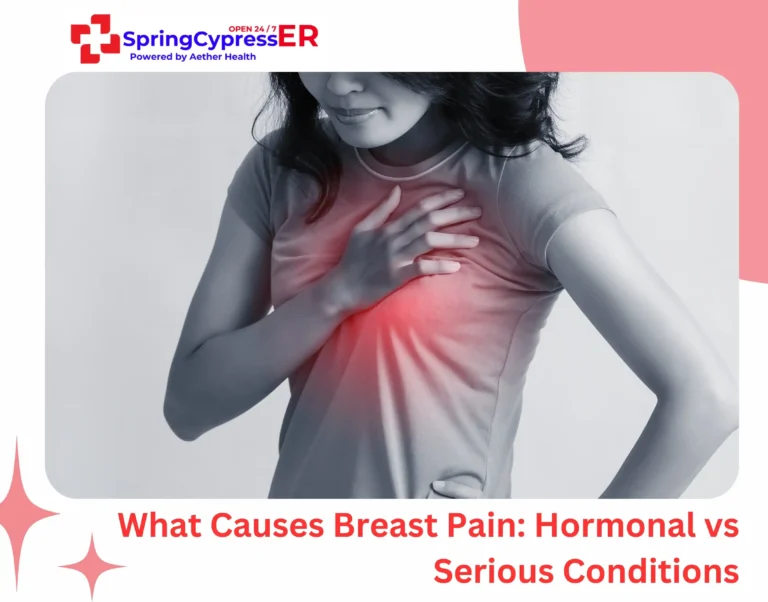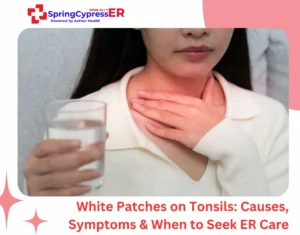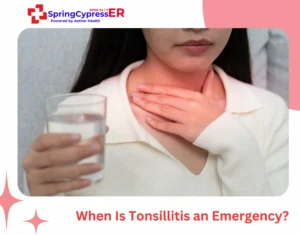Girls, you know that sore, heavy breasts are common before your period. But did you know that sometimes this feeling can be linked to infections or early signs of breast cancer?
Breast cancer is the most common cancer among women worldwide and the second leading cause of cancer death. If you know the difference between harmless breast pain and the kind that needs a checkup, you could help with early detection of breast cancer.
Let’s break down what causes breast pain, what’s normal, what’s not, and how to tell if it’s hormonal or something more serious that needs attention right away.
What Causes Breast Pain: Hormonal and Non-Hormonal Factors

Breast pain, also called mastalgia, is often caused by hormonal fluctuations that occur naturally during menstrual cycles, pregnancy, and menopause. When these hormone levels fluctuate, they can cause your breasts to feel sore, tender, or swollen.
Hormonal breast pain is usually normal and not something to worry about. This type of pain usually affects both breasts and improves once hormone levels stabilize.
Let’s take a look at what causes hormonal breast pain:
1. Menstrual Cycle
It’s common to feel breast pain a few days before your period starts. Your breasts might feel heavy, sore, or a little lumpy. The pain usually goes away once your period ends.
2. Pregnancy
In early pregnancy, breast tenderness is one of the first signs many women notice. Your breasts may feel fuller, more sensitive, or even tingly due to hormone changes.
3. Birth Control or Hormone Therapy
Taking birth control pills or going through hormone replacement therapy (HRT) can sometimes cause breast discomfort. These medications alter your natural hormone patterns, sometimes causing persistent breast tenderness that differs from natural cyclical pain.
4. Menopause
As your body goes through menopause, hormone levels can change a lot. This might cause occasional breast pain, especially in the years leading up to menopause (called perimenopause).
5. Fibrocystic Breasts
If your breasts feel lumpy, heavy, or achy before your period, you might have fibrocystic breasts. It’s a common condition where the breast tissue changes with your hormone levels. The pain usually settles down once your period starts.
Other Factors Causing Breast Pain
While most breast pain stems from normal hormonal patterns, certain warning signs indicate conditions requiring immediate medical evaluation. These serious factors don’t follow typical menstrual cycles and may signal infections, inflammatory conditions, or other health issues needing prompt treatment. Below are some signs that your breast pain might be more than just a hormonal change:
1. Persistent Pain in a Specific Spot
If the pain stays in one area of your breast and doesn’t come and go with your period, it’s a good idea to get it checked.
2. A New Lump or Thickening
Feeling a lump in your breast doesn’t always mean cancer. But if you find something new that feels different or firm and doesn’t go away, have your doctor take a look.
3. Changes in Skin or Nipple
Watch for dimpling, redness, rashes, or peeling on the skin of your breast. Nipple discharge (especially if it’s clear or bloody) without squeezing is also a sign to get checked. It could be one of breast cancer symptoms requiring immediate evaluation.
4. Swelling, Warmth, or Sudden Pain
These symptoms often indicate infections like mastitis or other inflammatory conditions requiring prompt antibiotic treatment. Unlike hormonal pain, infection-related discomfort typically affects one breast and doesn’t improve with cycle changes.
5. A Family History of Breast Cancer
If close relatives have had breast cancer, you should be extra cautious about any unusual breast symptoms and get regular checkups.
Hormonal Vs Serious Breast Pain: Quick Comparison
| Characteristic | Hormonal Breast Pain | Serious Breast Pain |
| Timing | Cyclical, relates to menstrual periods | Persistent, no cycle pattern |
| Location | Both breasts, generalized discomfort | Often one breast or specific area |
| Pain Type | Aching, heavy, tender sensation | Sharp, stabbing, or burning |
| Duration | 1-2 weeks per cycle, then resolves | Continuous for weeks or months |
| Triggers | Menstrual cycle, pregnancy, hormones | No clear hormonal connection |
| Associated Signs | Breast swelling, general tenderness | Lumps, skin changes, nipple discharge |
| Response to Treatment | Improves with cycle completion | Doesn’t improve with time or hormones |
| Age Pattern | Most common in reproductive years | Can occur at any age |
Pain Under Left Breast: Chest Wall vs Breast Causes
Pain under left breast creates immediate concern because this specific location sits where breast tissue meets chest wall structures. Many women experience anxiety because they are unsure whether it’s a breast problem or something more serious involving the chest wall or heart.
Sharp Pain Under Left Breast: Common Causes
Sharp pain under left breast typically involves intercostal muscles, rib cartilage, and the lower portion of your pectoralis muscle. This pain often confuses women because the discomfort feels like it’s coming from inside the breast when it actually originates from deeper chest wall structures. Here are common causes of chest pain on the left side under the breast:
- Intercostal muscle strain: The most common cause of pain under the left breast of chest involves pulled chest muscles running between your ribs. These become strained from sudden movements, intense exercise, or prolonged hunching over a desk. The pain feels sharp and worsens when you breathe deeply, cough, or twist your body.
- Costochondritis: Inflammation of rib cartilage creates stabbing pain directly under the breast area. This condition often follows respiratory infections and intensifies with coughing, sneezing, or taking deep breaths. The pain concentrates at specific points where ribs connect to your breastbone.
- Pectoralis muscle injury: Strain from exercise or repetitive arm movements affects the lower portion of your chest muscle that extends beneath breast tissue. This creates deep, aching pain that worsens when moving your arm across your chest or during pressing motions like push-ups.
- Chest wall trauma: Direct impact to the chest from falls, sports injuries, or accidents can bruise muscles and cartilage beneath the breast. The resulting pain feels tender to touch and worsens with movement or deep breathing.
- Muscle spasms: Sudden, involuntary contractions of intercostal or pectoral muscles create intense, cramping pain. These spasms often result from dehydration, overexertion, or staying in awkward positions for extended periods.
- Postural strain: Prolonged hunching over computers or phones creates chronic tension in chest wall muscles. This develops into persistent, dull aching that concentrates beneath the left breast and worsens throughout the day.
True breast tissue doesn’t extend as far down as many women think. Pain in this lower area typically involves chest wall structures that happen to sit beneath breast tissue.
Pain Under the Left Breast of Chest: Identifying the Source
Pain under the left breast of chest requires distinguishing between chest wall and breast tissue origins. The location makes this challenging, but specific characteristics help identify the true source.
Chest wall indicators:
- Sharp, stabbing pain you can pinpoint with one finger
- Movement-related pain that worsens with arm movements or deep breathing
- Pressure sensitivity – pain increases when pressing directly on the area
- Positional changes – pain varies with body position or activity
Breast tissue indicators:
- Generalized aching affecting broader breast area
- Cyclical patterns correlating with menstrual periods
- Bilateral involvement – often affects both breasts
- Hormonal triggers – worsens before periods or during pregnancy
How to Do an At-Home Assessment for Breast Pain
Doing a quick self-check at home can help you better understand what’s going on with your body. Here’s a step-by-step guide to safely assess your breast pain at home:
- Try to notice where the pain is coming from
- Is the pain in one breast or both? Does it come and go, or is it constant?
- Stand in front of a mirror with your arms at your side. Look for changes in the shape or size of your breasts
- Check for nipple changes (like turning inward or crusting)
- Any redness, swelling, or visible lumps
- Move your fingers in small circles and check for any firm areas, lumps, or thickening that feels different from the rest of the tissue
- Seek medical help if you notice any discharge that is clear, bloody, or occurs without squeezing.
When to Worry About Breast Pain
Most breast pain can wait for a regular doctor’s appointment. But you should head to the emergency room if:
- You have severe pain in your chest that feels crushing or radiates to your arm (could be a heart issue).
- There’s sudden swelling, redness, and high fever (possible abscess or serious infection).
- You notice rapid changes in your breast shape, size, or skin.
- You’re pregnant and experiencing breast pain that’s sharp, unusual, or accompanied by other symptoms.
Breast Pain Diagnosis: What to Expect
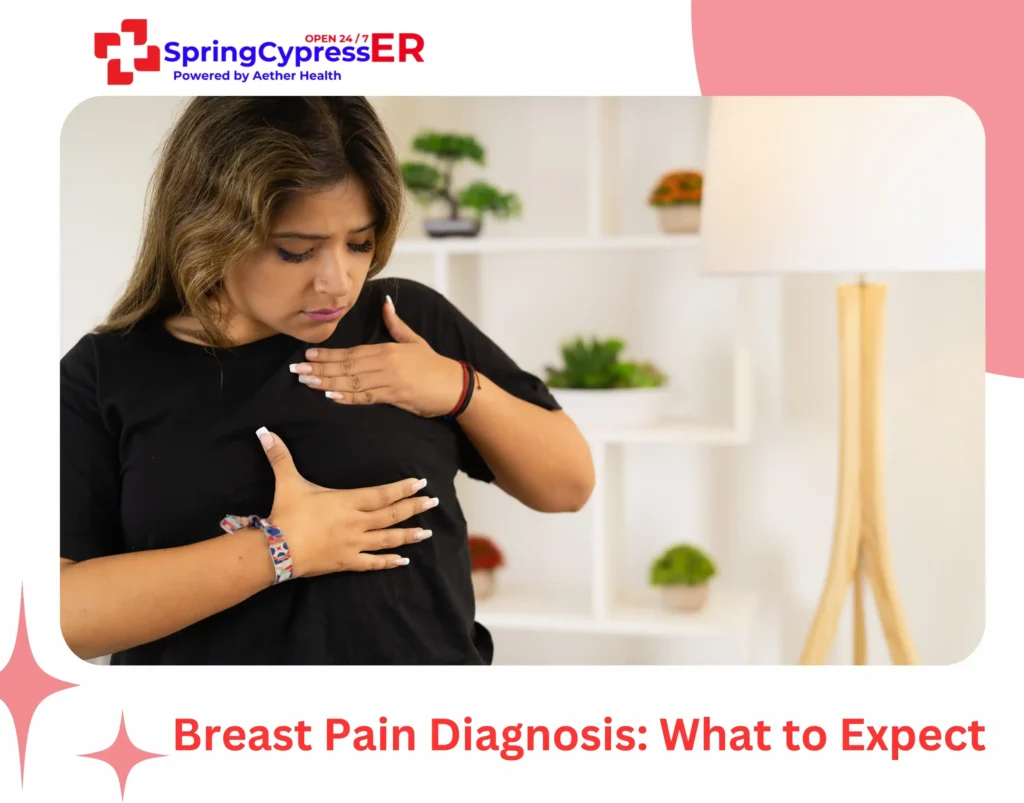
When you visit a healthcare provider for breast pain, they’ll start by discussing your symptoms and evaluating your personal and family medical history. Based on these findings, your doctor may recommend specific tests to determine the exact cause of your breast pain.
Tests you might need:
- Mammography: Breast X-rays to look for masses, calcium deposits, or other abnormalities
- Breast ultrasound: Sound wave imaging to examine specific problem areas or evaluate any lumps your doctor finds
- MRI scanning: Detailed imaging if you’re high-risk or if other tests show unclear results
- Hormone level testing: Blood work to check your estrogen, progesterone, and other hormone levels
- Biopsy: Tissue sampling only if imaging reveals something suspicious that needs definitive identification
The good news is breast pain in most cases is related to harmless hormonal fluctuations. Serious conditions causing breast pain are relatively rare.
What Can Help Relieve Breast Pain?
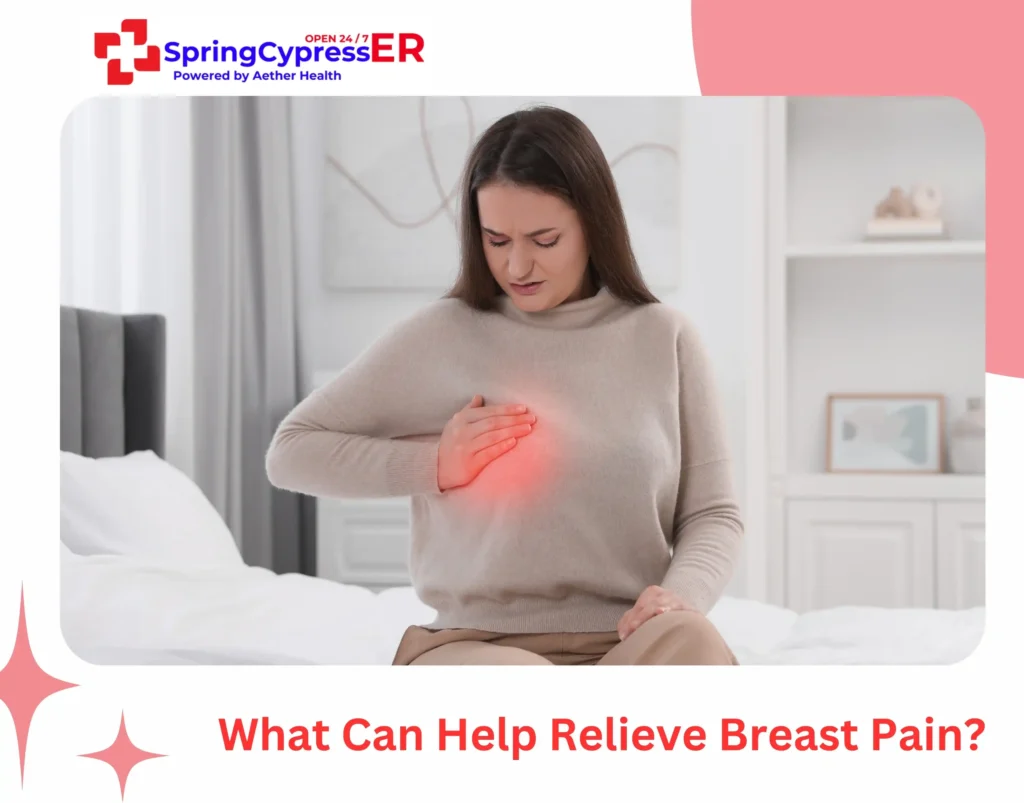
When you know what causes breast pain, you naturally want to know how to feel better. Here are some simple things you can try at home to ease the discomfort:
- Apply Warm or Cold Compresses: A warm towel, heating pad, or even a warm shower can help relax the breast tissue. If the area feels swollen, a cold pack might help reduce inflammation.
- Cut Back on Caffeine and Salty Foods: Some women notice less breast pain when they reduce coffee, tea, chocolate, and salty snacks. It’s not proven for everyone, but it’s worth trying if you’re sensitive to it.
- Stay Hydrated and Eat Balanced Meals: Drinking enough water and eating healthy foods can help reduce bloating and hormone swings that make breast pain worse.
- Manage Stress: Stress can make breast pain worse. Gentle activities, such as walking, deep breathing, or yoga, may help your body relax and reduce pain.
Final Thoughts: Know Your Normal
Pay attention to what’s normal for your body, how your breasts usually feel during your cycle, when the pain starts, how long it lasts, where it shows up, and how intense it is.
Once you know what’s normal for you, it’s easier to spot when something’s off, like pain that comes at a weird time in your cycle, feels sharper or more intense than usual, only happens on one side, or just won’t go away.
A quick visit to your doctor or a 24/7 emergency room like ER of Spring Cypress can help you figure out what causes breast pain. Our onsite imaging and laboratory testing help us quickly find out what’s going on, begin treatment, and give you peace of mind.
FAQs
1. Is breast pain a sign of breast cancer?
No, most breast pain is caused by hormonal changes and is not linked to cancer. However, if the pain is in one spot, doesn’t go away, or comes with other changes like a lump or nipple discharge, it’s best to see a doctor.
2. Should I be worried about breast pain in just one breast?
Pain in one breast can be caused by common conditions, such as a pulled muscle, cyst, or infection. However, if the pain persists, feels sharp, or is localized to a specific area, consult a doctor.
3. What does serious breast pain feel like?
Serious breast pain is often in one specific area, long-lasting (more than a few weeks), and accompanied by a lump, skin changes, or nipple issues.
4. How long should breast pain last before I see a doctor?
If breast pain persists for more than two complete menstrual cycles or doesn’t follow your normal pattern, schedule a doctor’s appointment. Any sudden, severe, or one-sided pain warrants emergency evaluation regardless of timing.
5. Can stress cause breast pain?
Yes, stress can worsen breast pain by affecting hormone levels and increasing muscle tension in your chest and shoulders. Managing stress through exercise, relaxation techniques, or adequate sleep often helps reduce breast discomfort.

